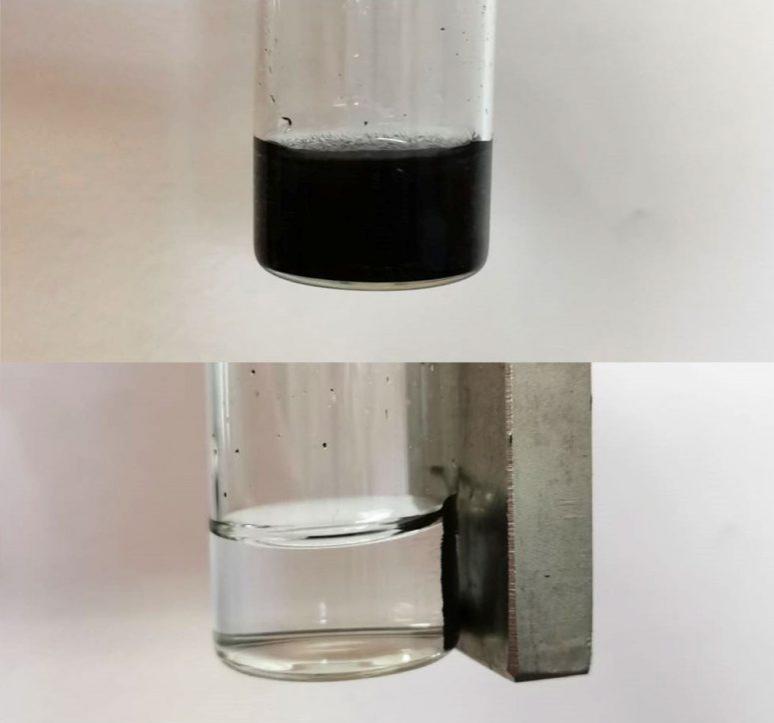博文
中国科学家用可重复使用的纳米颗粒催化剂清洁废水处理过滤膜的方式更环保
 精选
精选
||
中国科学家用可重复使用的纳米颗粒催化剂
清洁废水处理过滤膜的方式更环保
诸平
Nanoparticles (top image) efficiently break down pollutants and are magnetic, making them easily recoverable for reuse (bottom image). Credit: Adapted from ACS Applied Materials & Interfaces 2022, DOI: 10.1021/acsami.1c23466
据美国化学会(ACS)2022年3月2日提供的消息,中国科学院过程工程研究所生化工程国家重点实验室(State Key Laboratory of Biochemical Engineering, Institute of Process Engineering, Chinese Academy of Sciences, Beijing , China)和中国科学院大学化学工程学院(School of Chemical Engineering, University of Chinese Academy of Sciences, Beijing, China)的研究人员,使用可重复使用的纳米颗粒催化剂清洁废水处理过滤膜的方式“更环保”(A “Greener” Way To Clean Wastewater Treatment Filters With Reusable Nanoparticle Catalysts)。上述图示中纳米颗粒(上图)有效分解污染物并具有磁性,使其易于回收再利用(下图)。相关研究结果于2022年3月2日已经在-《ACS应用材料与界面》(ACS Applied Materials & Interfaces)杂志网站发表——Jinxuan Zhang, Huiru Zhang, Yinhua Wan, Jianquan Luo. Chemoenzymatic Cascade Reaction for Green Cleaning of Polyamide Nanofiltration Membrane. ACS Applied Materials & Interfaces, Publication Date: March 2, 2022. DOI: 10.1021/acsami.1c23466. https://pubs.acs.org/doi/10.1021/acsami.1c23466
膜过滤器不需要太多能量来净化水,因此在废水处理中很受欢迎。为了使这些材料保持最佳状态,通常使用大量强效化学品对其进行清洁,但其中一些试剂会在此过程中破坏膜。现在,中国科学院中国科学院过程工程研究所的研究人员 已经开发出可重复使用的纳米颗粒催化剂,该催化剂包含葡萄糖,以帮助有效分解这些过滤器内的污染物,而不会损坏它们。
通常,脏污的废水过滤膜不会被强酸、强碱或氧化剂堵塞。漂白剂等含氯氧化剂可以分解最顽固的有机碎屑,但它们也会损坏大多数商业纳滤系统(nanofiltration systems)中的聚酰胺膜(polyamide membranes),并产生有毒的副产品。一种较温和的漂白剂替代品是过氧化氢,但它会缓慢分解污染物。
此前,科学家将过氧化氢与氧化铁结合形成羟基自由基,从而提高过氧化氢在芬顿反应(Fenton reaction)过程中的效率。然而,为了使芬顿清洁过滤膜,需要额外的过氧化氢和酸,从而增加了费用成本和环境成本。避免这些额外化学物质的一种方法是使用葡萄糖氧化酶(glucose oxidase),它同时从葡萄糖和氧气中形成过氧化氢和葡萄糖酸。因此,罗建泉(Jianquan Luo音译)及其同事希望将葡萄糖氧化酶和氧化铁纳米颗粒结合到一个系统中,以催化基于芬顿反应的污染物分解,为过滤膜创建一个高效而精细的清洁系统。
首先,研究人员将通过葡萄糖氧化酶和氧化铁纳米颗粒从聚酰胺过滤器中去除有机污染物与其他清洁方法(包括传统的芬顿反应)进行了比较。他们发现这种方法在分解常见污染物双酚A(bisphenol A)和亚甲蓝(methylene blue)方面表现出色,同时还保留了更多的膜结构。
受到初步结果的鼓舞,该团队将葡萄糖氧化酶和氧化铁组合成一个纳米颗粒,并通过氨基桥(amino bridge)将它们连接起来。最后,他们测试了新的纳米颗粒清洁亚甲蓝浸泡过的纳米过滤膜的能力,他们污染和清洁进行了3个循环。在每个清洁周期后,用磁铁回收纳米颗粒并与新鲜葡萄糖一起重新使用以激活催化剂。
纳米颗粒在清洁膜方面非常有效,使它们恢复到其初始水过滤能力的 94%。由于纳米颗粒不需要强化学物质并且很容易回收,研究人员说他们的新系统是一种清洁纳米过滤膜的“更环保”和更具成本效益的方法。此研究得到了中国北京市自然科学基金(Beijing Natural Science Foundation, China)和中国国家自然科学基金(National Natural Science Foundation of China)的资助。
上述介绍,仅供参考。欲了解更多信息,敬请注意浏览原文或者相关报道。

Chemical cleaning is indispensable for the sustainable operation of nanofiltration (NF) in wastewater treatment. However, the common chemical cleaning methods are plagued by low cleaning efficiency, high chemical consumption, and separation performance deterioration. In this work, a chemoenzymatic cascade reaction is proposed for pollutant degradation and polyamide NF membrane cleaning. Glucose oxidase (GOD) enzymatic reaction in this cascade system produces hydrogen peroxide (H2O2) and gluconic acid to trigger the oxidation of foulants by Fe3O4-catalyzed Fenton reaction. By virtue of the microenvironment (pH and H2O2 concentration) engineering and substrate enrichments, this chemoenzymatic cascade reaction (GOD–Fe3O4) exhibits a favorable degradation efficiency for bisphenol A and methyl blue (MB). Thanks to the strong oxidizing degradation, the water flux of the NF10 membrane fouled by MB is almost completely recovered (~95.8%) after a 3-cycle fouling/cleaning experiment. Meanwhile, the chemoenzymatic cascade reaction improves the applicability of the Fenton reaction in polyamide NF membrane cleaning because it prevents the membrane from damaging by high concentration of H2O2 and inhibits the secondary fouling caused by ferric hydroxide precipitates. By immobilizing GOD on the aminated Fe3O4 nanoparticles, a reusable cleaning agent is prepared for highly efficient membrane cleaning. This chemoenzymatic cascade reaction without the addition of an acid/base/oxidant provides a promising candidate for sustainable and cost-effective cleaning for the polyamide NF membrane.
https://m.sciencenet.cn/blog-212210-1327925.html
上一篇:每周坚持肌肉强化活动半到1小时,可降低死亡风险10%-20%
下一篇:蓄暑热供冬用新技术
